
Run the Business, Change the Business
A Key to Implementing
Process Management
Overview
An important client once responded to a question about what his single biggest challenge was by saying:
“I feel like I’ve got to run this business every day or we’re not going to eat at the end of the month.
And I feel like I’ve got to change the way we do business or we’re not going to be eating this time next year!”
So there it was, right out in the open – the thing that many managers struggle with the most – the absolute, inviolate need to change an organization while it is operating.
However, it is not easy. Significant change is very difficult to implement into the day-to-day operation of a complex organization. Endeavor has developed a model for managing these types of complex changes that facilitates keeping the change initiative on track while maintaining effective operational imperatives.

A Dual-track Management System
In the context of a significant transformational initiative, a dual-track management system is required. Endeavor calls its model “Run the Business/Change the Business” (RTB/CTB). No change initiative occurs in a vacuum. By definition, the change initiative must be implemented while the organization is doing its “day job” of producing products, serving customers, collecting monies, and so on … in order to keep the business alive make a profit for share/stakeholders.
While there are a number of moving parts to the full-blown RTB/CTB Management System, a simple form can easily be visualized. Imagine a senior executive team that meets every Monday. Imagine that the morning session focuses only on Run-the-Business issues (e.g., progress toward financial targets, status on actions to fix customer upsets, manufacturing breakdowns, etc.).
Further, imagine that same executive team meeting each Monday afternoon to focus exclusively on the progress the organization is making to implement a significant change like Process Management (e.g., who are the next managers to get PM training in Boston, what is the progress on the pilot PM project in Department X, what is the status of the task force that is mapping core processes, how is HR coming in designing an incentive/compensation system that will reward individual managers’ progress, etc.).
The regular practice of the two executive meetings each Monday becomes a basic management construct that provides focus and balance to both “running” and “changing” the business. This simple idea can be extremely valuable because it moves the thinking from an unconscious “implement the change or run the business” to a conscious “implement the change and run the business.”
What follows is a more detailed version of the RTB/CTB model. This describes the implementation of any “big change,” but it uses examples based on the implementation of Process Management.
Doing Two Things at Once
Change does not occur in a vacuum. The boss cannot shut down the day-to-day business in order to work on the latest change initiative…no matter how powerful or glamorous it might be. He cannot even say “let’s run the business and change the business on alternating days. It has to happen simultaneously. An organizational change should not be initiated until senior management has acknowledged this fact and adopted an approach to deal with it.
Step 1: Everyone Must Have the Dual Perspective
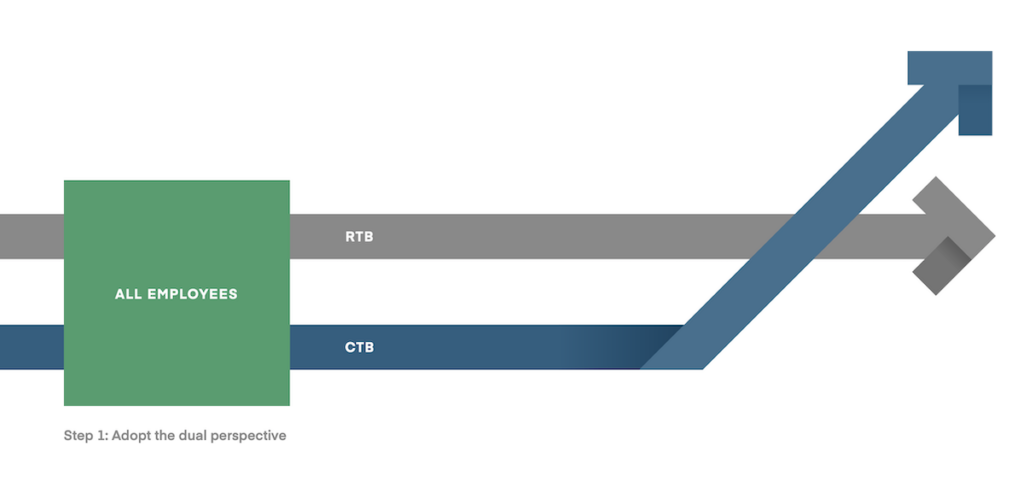
The starting point for running the business, while changing the business, is maintaining a “dual perspective”. This is illustrated with the two paths in Step 1. The two paths represent both the running of day-to-day business, fulfilling today’s orders for today’s customers using the means the company has at handas well as the initiatives that a company is taking to change the way it is currently doing business – changing work processes, modifying plant, equipment, and tools to match those changed processes, then changing employee contracts, and providing necessary training to perform the new processes. An ongoing dual perspective is a requirement for implementing any change, whether it is a change toward Process Management or assimilating a newly-merged business unit.
Understanding the dual perspective is one thing; getting everybody to accept it as part of the normal job another. Unfortunately, most employees in many companies think of change as the exception and not the rule. Many of these employees have somehow concluded that “the job” is only to run the business (that is, to do the same kind of work over and over again with little change). That condition must change. With “change is the rule” these days and not the exception, it makes no sense to have workers on board who are not signed up for both running and changing the business.
Getting a dual perspective in place across the organization requires a change in the performance contract. Leaders who want to be successful at both running and changing the business must have everyone in the organization under agreement to participate and be accountable for both. To complete this new agreement, senior managers must go first, demonstrating with their own behavior a focus on both doing today’s business and working today to change the way business is done. Then leaders must talk openly and often about change being the rule and about the new agreement the company needs to have with all employees.
Step 2: Power Both Perspectives
It is largely self-evident that an organization needs continuous energy from leadership or the organization will tend to lose focus on either the run or the change front. Leadership energy should “power” both the RTB and the CTB perspectives.
Not only must there be energy to power both perspectives, the energy needs to come from different sets of leaders, as illustrated in Step 2.
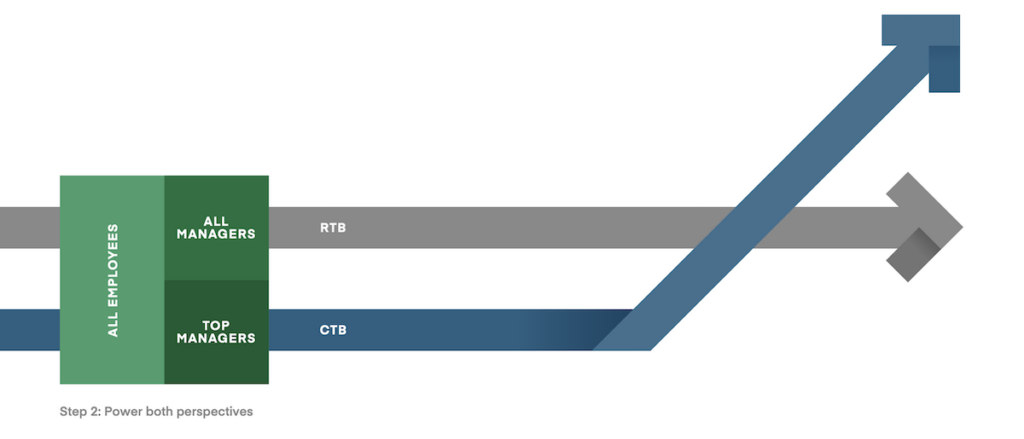
For an organization to have a chance of success at change, it must depend on top management to supply the leadership energy and focus necessary to power the change-the-business perspective. Lower-level managers must supply the leadership energy and focus necessary to run the business on a day-to-day basis. That said, these two groups should NOT operate separately. Both top management and lower management are involved in changing the business, with top management in the lead. Both top management and lower management are involved in running the business, but lower management is in the lead.
This leadership distinction is critical because usually only top management has the authority, credibility, and organizational horsepower needed to effectively lead change initiatives. They are the ones who can say “This is the way we are going to be doing things.” They can authoritatively change what is expected of employees and adopt systems to make it stick.
Employees need leaders who can get their attention and pull them out of the trees to see the forest. In addition, employees need leaders who insist that they will both run the present business and do their part to change the business.
This illustration shows what happens when companies try to change with the wrong leaders powering change.
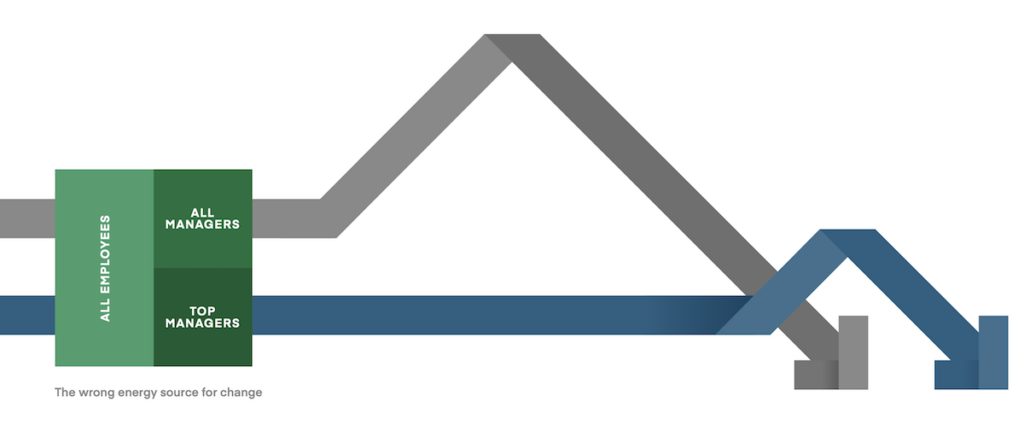
If senior management focuses on running the business while changing the business is left to other managers or to staff, the effort is usually doomed – sooner rather than later. Sure, some other managers and staff may be trying to lead and focus the CTB initiatives, but they are not likely to be successful.
If top management is running the business it indicates that their top priority emphasizes today’s products for today’s customers; the workforce will pay attention and follow that lead. Not only will the organization suffer from this misplaced use of energy, but the other managers who are trying to make the change happen will frequently become the victims of fatigue, burnout, and sometimes political damage.
Step 3: Guide Change with a Clear Vision
For employees to be able to meet their RTB and CTB responsibilities they must have a clear and understandable picture or vision of the desired organizational future, as illustrated in Step 3. This means that all the managers in an organization need to have a clear idea of where it is going so that they can ensure that their day-to-day actions in running the business do not compromise the eventual destination.

The vision must show future run-the-business results that obviously cannot be achieved without the change being realized on a day-to-day basis. The vision must be accompanied with the case for change. If the vision does not make the need for change and the benefits of change obvious, it cannot serve as the energizer for change.
For example, vision sentences like the following begin to bring out a rich picture of a future with Process Management:
- Our way of operating in 2015 will require that all core processes be mapped in detail, that metrics of process performance be in place, and that the owners assigned to those processes be compensated in accordance with process performance.
- Our way of operating in 2015 will require us to analyze process performance continuously, finding and improving process weak spots until process performance meets or exceeds targets.
The sample sentences above carry far more detail and paint a more understandable picture than common bullet point visions.
For the vision to be credible, it must be kept up to date. If views of the future change or if the objective changes, a new or updated vision is called for. Many managers believe that a vision, once detailed, cannot easily be changed or the organization will become disoriented. However, the exact opposite is true. The organization knows when its vision is out of sync with some new marketplace reality and they read “out of sync” as “leaders asleep at the switch.” They will also notice when the change work seems no longer to be pointed at the publicized vision and they will wonder if something secret is going on. So when the vision needs to change in some way, change it. Keep it fresh and up to date. Show the organization a leadership team that is “with it” and on the ball so that it is much more likely that an organization will be on board with vision implementation.
Step 4: Lead with Two Clear Agendas
Lead the organization with two agendas (meaning two goals or project lists) – one for running the business, the other for changing the business. As shown in Step 4, if management wants the organization to have the dual perspective and to change the business while running the business, then management must provide clear path descriptions for both.
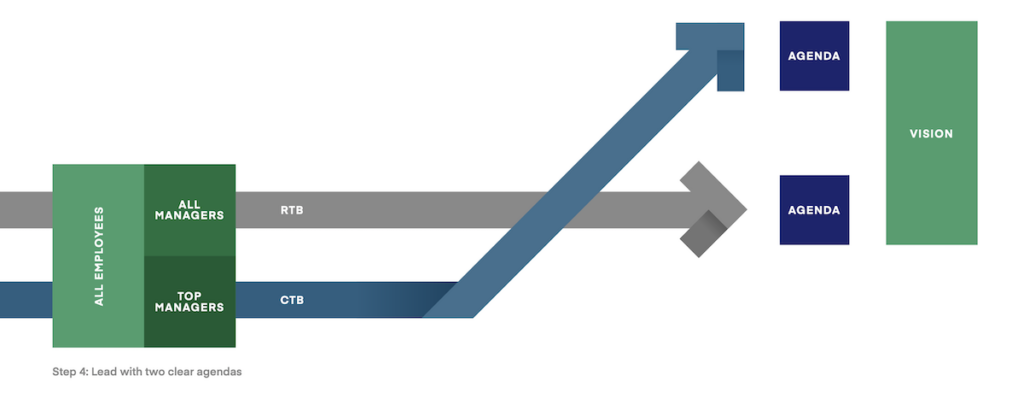
Almost all organizations have a list of the RTB things they want to accomplish. This is their run-the-business agenda, often called the profit plan, the budget, or the list of company goals – market share, net profit, return on investment, and cash flow will always be there with challenging targets. Managers know that the best tool for giving their organization a sense of direction for the upcoming year is a clear, concise list of measurable goals.
If it makes sense to have a clear set of goals for running of the business, then it should also make sense to have a clear set for changing of the business. Unfortunately, it is rare to find an agenda that is clear about its change goals for any given year. The problem is compounded when the two are mixed into a single list so it is not obvious which is which.
So, two lists are called for, and this is where to get them: The goals on the run-the-business agenda come out of the company’s normal profit or business planning cycle. In this cycle, company planners forecast the business/market situation, competitor moves and positions, general economic conditions, and many other things to come up with ideas for next year’s goals. These goals are normally expressed in terms of operating results – sales revenue, market share, customer satisfaction, position on industry indices, return on investment, and so on.
The process for identifying goals for changing the business is very different, but not all that complicated. Change goals for any given year come from the long sequential list of steps the company will need to take in order to reach its future state. This list is the “change queue” of actions that are critical to put a vision into place. Then for each calendar year on the way to that vision, the organization’s top management develops the change agenda by including the next steps in the sequence already planned, limited by recognition of the nature of the run-the-business work likely to be required during the year and the availability of resources to do the change work.
For example (using a Process Change frame of reference):
Run-the-Business goals for next year
- Net profit of $23M
- Cash flow of $15M 3. ROI of 13%
- Market share of 16%
Change the Business goals for next year
- All senior executives attend the Hammer course on Process Management
- CEO mentions the importance of PM on each and every plant tour
- One business process selected as a pilot of process management. The process will be:
a. Mapped using IDEF
b. Given metrics
c. Have an identified owner
d. Subjected to continuous improvement - Results of the process pilot will be written into the company newsletter and annual report
This simple example illustrates some clear distinctions between run and change goals. While run goals are normally stated as “results,” change goals are stated much more like “projects or tasks.” For change goals that are really tough or long range, it is a good idea to break the goals into shorter-range, intermediate milestones whose accomplishments will show some progress and keep the organization’s momentum going.
What happens when a change goal is met? It is replaced with the following change goal that must be accomplished to reach the destination. The change agenda becomes the “running hot projects list” that is back-filled continuously and never runs short of work to be done.
The bottom line on these two agendas is simple and straightforward. For an organization to run and change at the same time, two equivalent agendas must be put in place. Perhaps the biggest payoff of the idea of the change agenda is that it takes a relatively complex task – reaching the vision – and turns it into a list of straightforward steps to accomplish for the next business period. By achieving change goals this year, the vision will take care of itself.
Step 5: Establish Scorecards and Consequences
If a company has a list of important run-the-business goals, it will probably have a way of measuring the accomplishment of those goals. In addition, key managers in the company will likely be assigned the responsibility for goal accomplishment, and their compensation will likely be tied to results. This method is necessary because managers have learned over the long haul that assigning responsibility, measuring results, and tying compensation to those results really works.
If a company expects results on its change agenda, the same approach should apply.
- Each item on the change agenda must have a measure.
- Someone must be held accountable for results on that item, and
- That person’s compensation must be tied to the result.

To achieve results on both agendas, those agendas must be managed in the same way. Step 5 shows that the results of both agendas must be measured and the results tied to personnel compensation. Rarely, a company does not tie run-the-business results to the compensation of its key managers. At the same time, it is relatively rare to find a company that gives the same accountability and compensation weight to results on the change agenda.
Words alone are not enough incentive for change; motivation for change will only occur when it is tied to compensation.
So what might appear on a change scorecard? The change scorecard is simply a progress report on the milestones associated with items on the change agenda. The change scorecard should reflect actual results that show real progress on constructing or positioning the assets that will support the vision being implemented.
Step 6: Manage Results in Two Forums
Most well run companies already use management forums for their run-the- business results (these meetings are called everything from profit meetings to variance reports). Some companies have monthly meetings while others opt for quarterly reviews of results.
It is critical to review change results in a management forum as well. The organization must focus the same management energy and intensity on change results as it does on the run results.
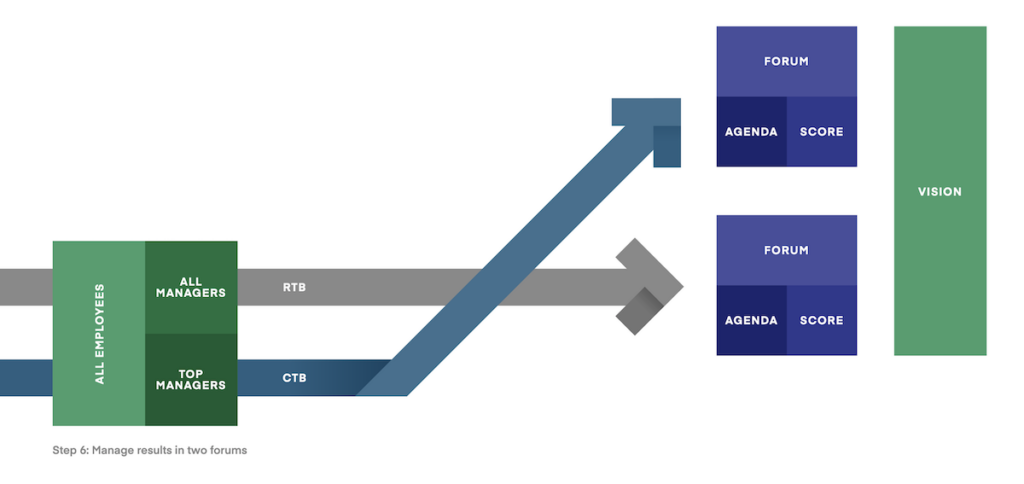
As illustrated in Step 6, it is crucial to have a separate change forum for discussion of change results. This takes place in the form of extra separate meeting that is exclusively focused on change. Not only should the run and change forums be separate, they should be equal in order to send the dual perspective message. If the run-the-business forum is held in the boardroom, the change-the-business forum should be held there as well. If the format for the run forum is formal, the format for the change forum should be formal as well.
Each forum should be biased toward its targeted result, but have cognizance of the other agenda. For example, in a run-the-business forum, the results reported will be operational oriented, but in the discussion of actions that might be needed to get back on track in an operating area, the managers in the forum should be aware of the impact of those considered actions on the change agenda. The forum must ensure that the run actions it approves do not take all the steam out of the change agenda. It frequently takes strong leadership from senior management to keep things balanced here because it’s frequently an “easy out” to take energy away from change to get an immediate run-the- business result.
The discussion in a change-the-business forum should be focused on those initiatives or projects that are aimed at meeting change goals. For example, the selection and mapping of a core process as a model for process management might be the subject in a change forum: what process was selected, who are the candidates to be process owner, what measures are being evaluated, what about timing … is the pilot on schedule?
Step 7: Lead Change Through Opportunities
In a way, the six steps identified so far are all oriented to “positioning the organization” to be able to change the business while it runs the business. The first six steps in essence put the management and organizational machinery in place to get both jobs done. Step 7 focuses on the day-to-day operation of the business and gives guidance for how to meld run-the-business work with change-the-business work.
Companies that have mastered change do a very good job of coordinating their run-the-business work with their change-the-business work. That is, they know how to relate a change initiative to a key run-the-business initiative so that two things do not interfere with each other and might even be synergistic with each other. In fact, the company may even reschedule an item from its change agenda in order to substitute one from its change-initiative queue that fits better with the run-the-business goals.
For example, the schedule for executives to go to Process Management training might be varied during the year because of operational priorities. As long as all the execs get the training, does the order really matter?
Or imagine a more serious case, where the company comes upon a major business opportunity that can be exploited for that year’s run the business goals. Imagine halting the mapping of the selected core process and changing to another process that would be most critical to support that business opportunity. Should the company care which process gets mapped in the present year? As long as the company gets its process mapped, measured, and owned, its future vision of implemented PM will be unaffected.
Companies that handle change successfully willing to let the run-the-business initiatives lead because those initiatives are keeping the companies in immediate sync with their customers and investors.

There are four actions, illustrated in Step 7, for management to take to ensure that both run and change business are being done as effectively and efficiently as possible. First, senior management needs to continuously scan the run-the- business situation to look for opportunities – business transactions that might be carriers of change initiatives.
Second, it is important for senior management to select those run-the-business initiatives that are both critical for next year’s business success and that could be potential carriers of change initiatives. Selection means to pair an initiative from the change agenda with a key run-the-business transaction. This takes some courage to do because intuition might lead in the opposite direction (e.g., avoid changing a major work process while completing the biggest order of the year).
Third, senior management’s job then is to personally lead what are now the selected paired or joint initiatives for both the running and the changing of the business. It is critical for the senior manager to communicate to the organization the importance of the joint initiatives and the reason for personal involvement at the senior level. In situations like this, there is little room for failure of either part of the joint endeavor. But with success comes the fourth action – the chance to leverage the good results. There is no better role model for running while changing the business than the senior manager who personally shows how it is done.

A Call to Action
Changing the business while running the business takes a lot of determination and at least a little bit of courage. However, gutsy, dedicated leadership following the seven steps can get real results. Failure to manage both run and change in equally disciplined ways will result in the run agenda going to the front and the change initiative eventually dying and falling off the plate. Organizations everywhere have experienced “a bold charge into change” followed by decreasing energy, apathy, and then cynicism. The bottom line is that if a company sees the value of change, it should not pass up a Run the Business/Change the Business model.
Let’s Talk
We will help you overcome strategic challenges to realize the business value you seek.
